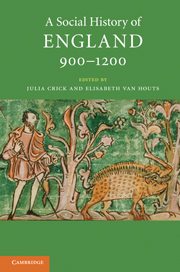Book contents
- Frontmatter
- Contents
- List of figures
- List of maps and tables
- List of contributors
- Acknowledgements
- List of abbreviations
- Map 1 England and its neighbours
- Map 2 England 900–1200
- I Introduction
- I.1 Land use and people
- I.2 Water and land
- I.3 Forest and upland
- I.4 Mineral resources
- I.5 Health and disease
- II.1 Authority and community
- II.2 Lordship and labour
- II.3 Order and justice
- II.4 War and violence
- II.5 Family, marriage, kinship
- II.6 Poor and powerless
- III.1 Towns and their hinterlands
- III.2 Commerce and markets
- III.3 Urban planning
- III.4 Urban populations and associations
- IV.1 Invasion and migration
- IV.2 Ethnicity and acculturation
- IV.3 Intermarriage
- IV.4 The Jews
- V.1 Religion and belief
- V.2 Rites of passage and pastoral care
- V.3 Saints and cults
- V.4 Public spectacle
- V.5 Textual communities (Latin)
- V.6 Textual communities (vernacular)
- VI.1 Learning and training
- VI.2 Information and its retrieval
- VI.3 Esoteric knowledge
- VI.4 Medical practice and theory
- VI.5 Subversion
- Glossary
- Time line 900–1200
- Further reading
- Index
- References
V.3 - Saints and cults
Published online by Cambridge University Press: 05 June 2012
- Frontmatter
- Contents
- List of figures
- List of maps and tables
- List of contributors
- Acknowledgements
- List of abbreviations
- Map 1 England and its neighbours
- Map 2 England 900–1200
- I Introduction
- I.1 Land use and people
- I.2 Water and land
- I.3 Forest and upland
- I.4 Mineral resources
- I.5 Health and disease
- II.1 Authority and community
- II.2 Lordship and labour
- II.3 Order and justice
- II.4 War and violence
- II.5 Family, marriage, kinship
- II.6 Poor and powerless
- III.1 Towns and their hinterlands
- III.2 Commerce and markets
- III.3 Urban planning
- III.4 Urban populations and associations
- IV.1 Invasion and migration
- IV.2 Ethnicity and acculturation
- IV.3 Intermarriage
- IV.4 The Jews
- V.1 Religion and belief
- V.2 Rites of passage and pastoral care
- V.3 Saints and cults
- V.4 Public spectacle
- V.5 Textual communities (Latin)
- V.6 Textual communities (vernacular)
- VI.1 Learning and training
- VI.2 Information and its retrieval
- VI.3 Esoteric knowledge
- VI.4 Medical practice and theory
- VI.5 Subversion
- Glossary
- Time line 900–1200
- Further reading
- Index
- References
Summary
No two cult centres in England have exactly the same history between ad 900 and 1200, but if there is a general pattern it is that the period saw three great surges of interest in saints and their cults: the first took place at the end of the tenth century, the second in the six decades between 1070 and 1130 and the third and the most diffuse during the last three decades of the twelfth century. These periods saw efforts on the part of the leading churches to introduce new cults or to renew old ones. At Thorney, for example, there was much activity during the first two phases: diverse cults were relocated to the abbey when it was founded in the 970s; several of these cults – those of Botulf, Tancred, Torhtred and Tova – were subsequently equipped with vitae by Folcard, the viceabbas whom William the Conqueror appointed in about 1069; in 1098 the relics were translated to a new church built by Abbot Gunther, who had succeeded Folcard in 1085; more relics were then acquired in 1105 and 1111 – relics of Theodore the Martyr and then relics of the founder St Æthelwold himself; but there is little sign that the abbey's repertoire of cults was expanded or that they were provided with further textual support during the remainder of our period.
- Type
- Chapter
- Information
- A Social History of England, 900–1200 , pp. 309 - 320Publisher: Cambridge University PressPrint publication year: 2011
References
- 2
- Cited by



